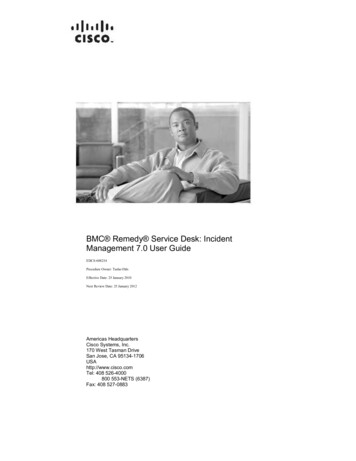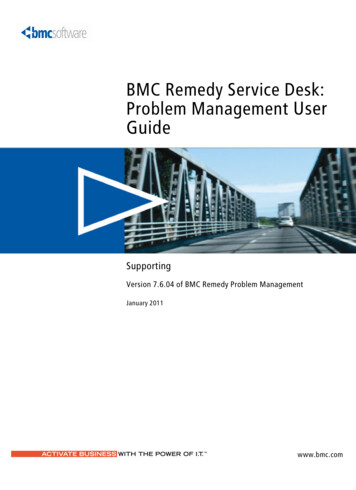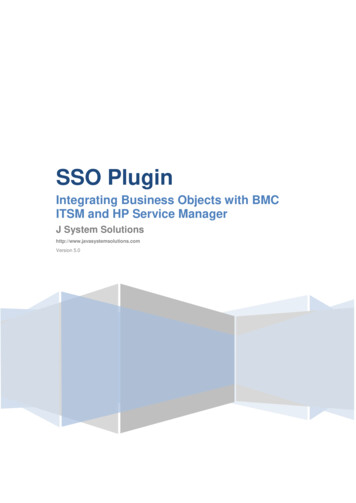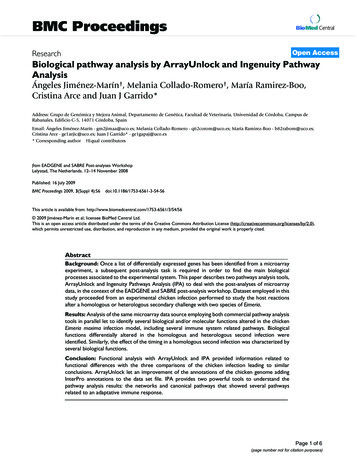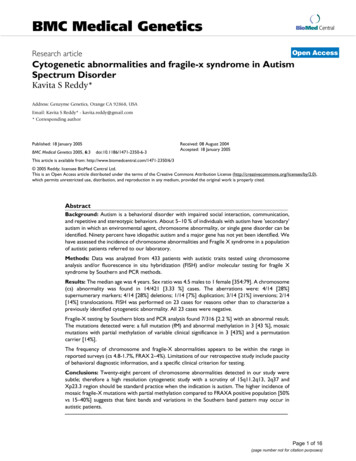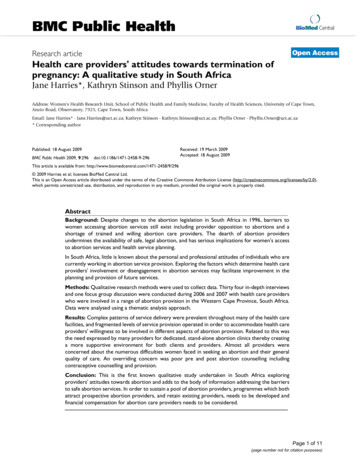
Transcription
BMC Public HealthBioMed CentralOpen AccessResearch articleHealth care providers' attitudes towards termination ofpregnancy: A qualitative study in South AfricaJane Harries*, Kathryn Stinson and Phyllis OrnerAddress: Women's Health Research Unit, School of Public Health and Family Medicine, Faculty of Health Sciences, University of Cape Town,Anzio Road, Observatory, 7925, Cape Town, South AfricaEmail: Jane Harries* - Jane.Harries@uct.ac.za; Kathryn Stinson - Kathryn.Stinson@uct.ac.za; Phyllis Orner - Phyllis.Orner@uct.ac.za* Corresponding authorPublished: 18 August 2009BMC Public Health 2009, 9:296doi:10.1186/1471-2458-9-296Received: 19 March 2009Accepted: 18 August 2009This article is available from: http://www.biomedcentral.com/1471-2458/9/296 2009 Harries et al; licensee BioMed Central Ltd.This is an Open Access article distributed under the terms of the Creative Commons Attribution License (http://creativecommons.org/licenses/by/2.0),which permits unrestricted use, distribution, and reproduction in any medium, provided the original work is properly cited.AbstractBackground: Despite changes to the abortion legislation in South Africa in 1996, barriers towomen accessing abortion services still exist including provider opposition to abortions and ashortage of trained and willing abortion care providers. The dearth of abortion providersundermines the availability of safe, legal abortion, and has serious implications for women's accessto abortion services and health service planning.In South Africa, little is known about the personal and professional attitudes of individuals who arecurrently working in abortion service provision. Exploring the factors which determine health careproviders' involvement or disengagement in abortion services may facilitate improvement in theplanning and provision of future services.Methods: Qualitative research methods were used to collect data. Thirty four in-depth interviewsand one focus group discussion were conducted during 2006 and 2007 with health care providerswho were involved in a range of abortion provision in the Western Cape Province, South Africa.Data were analysed using a thematic analysis approach.Results: Complex patterns of service delivery were prevalent throughout many of the health carefacilities, and fragmented levels of service provision operated in order to accommodate health careproviders' willingness to be involved in different aspects of abortion provision. Related to this wasthe need expressed by many providers for dedicated, stand-alone abortion clinics thereby creatinga more supportive environment for both clients and providers. Almost all providers wereconcerned about the numerous difficulties women faced in seeking an abortion and their generalquality of care. An overriding concern was poor pre and post abortion counselling includingcontraceptive counselling and provision.Conclusion: This is the first known qualitative study undertaken in South Africa exploringproviders' attitudes towards abortion and adds to the body of information addressing the barriersto safe abortion services. In order to sustain a pool of abortion providers, programmes which bothattract prospective abortion providers, and retain existing providers, needs to be developed andfinancial compensation for abortion care providers needs to be considered.Page 1 of 11(page number not for citation purposes)
BMC Public Health 2009, 9:296BackgroundProviding greater access to safe abortion reduces the public health burden of unsafe abortion, which in 2004 wasestimated at 68,000 deaths and five million permanent ortemporary disabilities per annum, primarily in developing countries [1]. In countries where legislation permitstermination of pregnancy (TOP), access to safe inducedabortion may be restricted due to limited numbers oftrained health care providers [2]. To improve access to safeabortion and conserve scarce health resources, somecountries, including South Africa, have trained mid-levelproviders (MLP), i.e. health care providers who are notdoctors, such as midwives and registered nurses, to perform first trimester abortions [3].In South Africa, the Choice on Termination of PregnancyAct (CTOP) (No. 92 of 1996) promotes a woman's reproductive right and choice to have an early, safe and legalabortion. The CTOP Act allows for first trimester abortions (up to 12 weeks gestation) to be performed by midlevel providers comprising trained professional nursesand midwives, whereas second trimester abortions areprovided by doctors. As a result of this abortion legislation, abortion related morbidity and mortality havedecreased significantly by 90% [4]. However, despite liberal abortion reform laws there are still major barriers towomen accessing abortion services. These include provider opposition, stigma associated with abortion, poorknowledge of abortion legislation, a lack of providerstrained to perform abortions and facilities designated toprovide abortion services particularly in the rural areas [510].Abortion is a time-restricted health service. The currentlegislation provides for abortion on request up to andincluding 12 weeks of gestation. In cases of socio-economic hardship, rape, incest and for reasons related to thehealth of the pregnant woman or foetus, terminations canbe performed up to 20 weeks of gestation. From 20 weeksonward terminations are available only under very limited 58/9/296her refusal to carry out an abortion. Irrespective of conscientious objection, a nurse must provide nursing careincluding assistance with activities of daily living, emotional support, prescribed medications and comfort andpain relief measures.In recent years the number of abortions performednationally and in each of the provinces, including theWestern Cape has increased substantially, indicatingincreased availability and accessibility to abortion services[11]. Despite this manifold increase in demand and utilization, challenges exist in the further expansion of services, particularly through trained nurse or midwife serviceprovision up to 12 weeks gestation [12]. The shortage ofhealth care providers who are willing or trained to perform abortions undermines the provisions of the CTOPAct, by limiting the availability of safe, legal abortion, andhas serious implications for women's access to abortionservices and health service planning.There has been little research to date on health providers'attitudes towards abortion in South Africa [5,9]. Studieselsewhere, including countries where abortion is highlyrestricted, have found that various factors shape healthprofessionals' attitudes towards induced abortion [13].Religious beliefs, the reasons for seeking an abortion suchas rape or incest, and gestational age were all found toaffect attitudes and willingness towards abortion provision [13-15]. In South Africa, little is known about thepersonal and professional attitudes of individuals who arecurrently working in abortion service provision. Exploringthe factors which determine health care providers'involvement or disengagement in services may facilitateimprovement in the planning and provision of futureservices.This paper reports on results from a qualitative study thatexplored knowledge, attitudes and opinions of healthservice providers who are likely to play a critical role indetermining access to and the quality of these services.MethodsThe CTOP Act makes allowance for a health care provider's right to conscientious objection. This right is supported by the constitutional rights of all South Africans tofreedom of thought, belief and opinion. A health care provider may refuse to perform an abortion, however, theyare obliged to inform a woman of her reproductive rightto choose an abortion according to the Act, and to referher to another provider or facility. Ethical guidelines havebeen drafted by the South African Nursing Council withregards to conscientious objection and abortion provision. A nurse refusing to participate in the act of performing a TOP must lodge in writing to their employer his orStudy sitesThe study was conducted between July 2006 and October2007 across 3 public sector primary health care facilities;8 hospitals; 4 non-governmental organization (NGO)facilities, 3 of which provided abortions and 1 providingpregnancy counselling; and 2 health services linked to secondary and tertiary educational institutions. Researchsites were based within the greater Cape Town area andthree outlying areas within the Western Cape Province,South Africa. Facilities provided a range of representativeservices from pre abortion counselling and referral, to theprovision of first and second trimester abortions, postPage 2 of 11(page number not for citation purposes)
BMC Public Health 2009, bortion counselling and contraceptive services. Thestudy was based in the Western Cape for logistical andfunding reasons.tiary hospitals. The Western Cape is the only province inSouth Africa where D & E for second trimester abortionsis currently offered on a limited scale in the public sector.In most other provinces in South Africa within the publicsector, the medication method of abortion using misoprostol-alone is the preferred method for second trimesterabortions.Abortions at public sector facilities were available free ofcharge, while NGO facilities offered a mix of free and feerelated services. Facilities that offered first trimester abortions were either provided by mid-level providers whohad been trained in manual vacuum aspiration (MVA)techniques or by doctors. Facilities that provided bothfirst and second trimester abortions employed registerednurse midwives for terminations up to 12 weeks, and doctors for second trimester abortions. Some doctors whoprovided second trimester abortions formed part of a"roving team" of providers who rotated between publicsector facilities in the study sites. Most second trimesterabortions were performed using the dilation and evacuation (D & E) method. Misoprostol (Cytotec ) was administered to all abortion patients for cervical priming prior tothe MVA and D & E procedure. Medical abortion for firsttrimester abortions is not currently available in the publicsector. The medication method of abortion for second trimester abortions using misoprostol-alone which requiresa hospital admission of several days was used in some ter-Study respondentsA total of 34 in-depth interviews and one focus group discussion (comprising 4 counsellors) were conducted withhealth care providers who were involved in a range ofaspects of abortion service provision (see Table 1). Themajority of respondents were female (89%) and themedian number of years of experience in abortion serviceswas 7 years (range 0–30). Participants were selectedthrough purposive sampling. Due to the paucity of providers, snow ball techniques were used to identify bothproviders and non-providers for the study.The sample represented a range of health care providerswho varied by professional category (including doctors,registered nurses and midwives) and type of provider.These included providers who were trained to performTable 1: Background variables associated with TOP service provisionStudy sitesTraining statusService provider categoryPrimary Health Care facility3Hospital (Level 1, 2 or 3)8Non-governmental organizationOtherTotal4116Providing service – TrainedProviding service – Not trainedProviding service – Health care managerProviding service – Total160117NOT Providing service – TrainedNOT Providing service – Not trainedNOT Providing service – Health care managerNOT Providing service – Total117321CounsellorEnrolled NurseRegistered nurseNurse-midwifeDoctorManagement7231763Median number of years worked in TOP services (range)7 (0–30)Sex of providerMaleFemale434Religious affiliationChristianOtherNot specified19118Page 3 of 11(page number not for citation purposes)
BMC Public Health 2009, 9:296abortions and were providing abortions; providers trainedin abortion services but were not providing abortions, andproviders who were not trained in abortion procedures.Other respondents included nurses and counsellors whowere involved in pre and post abortion referral and counselling, and health care managers in facilities providingboth abortion and/or reproductive health care services.Study designQualitative in-depth interviews were conducted amonghealth care providers and health care managers who wereworking in facilities that provided abortion services in thepublic, private and NGO sectors. Owing to the sensitivityof the subject matter, and respect for privacy of participants, individual interviews were deemed the most appropriate method for data collection. A single focus groupdiscussion was held with four participants on theirrequest, as they felt more comfortable speaking in a grouprather than on an individual one on one basis. The interview guide was adapted accordingly to facilitate discussion.Interview guides were semi-structured, open-ended, andmade use of probes. Socio-demographic data were collected prior to the interview, and included gender, religious affiliation, training and qualifications, category ofprovider and years of experience as a provider. A pilotstudy was conducted to check for appropriateness andunderstanding, and revisions were made to improve theclarity and flow of the instrument. Interviewers, who hadexperience in qualitative research methods, conducted theinterviews in English. Interviews were approximately anhour in duration and were held in a private setting.Interviews were digitally recorded and transcribed verbatim. All participants provided written informed consent,and confidentiality and anonymity were ensured. Ethicalapproval was obtained from the Research Ethics Committee, University of Cape Town and the World HealthOrganization Research Ethics Review Committee.Approval to conduct the study was obtained from theWestern Cape Provincial Department of Health and fromthe NGO facilities.Data analysisData were analysed using a thematic analysis approach.Initial categories for analysing data were drawn from theinterview guide and themes and patterns emerged afterreviewing the data. Key themes to emerge were: reasonsproviders were not willing to provide abortions includingindividual and health service related barriers, how providers defined or conceptualised abortion, knowledge andunderstanding of the TOP legislation, and how reasonsfor seeking an abortion impacted on providers' decisionsto be involved in abortion /296The computer software package ATLAS ti 5.2 was used tofacilitate sorting and data management (Scientific Software Developments, 1998–2008). Members of theresearch team developed and refined the codes using thekey issues probed. The transcripts were coded by theresearch team and then cross checked for coder variation.The data were then reviewed for major trends and crosscutting themes were identified. Issues for further exploration were prioritised for final analysis. No codingdiscrepancies were encountered.ResultsComplex patterns of service delivery were prevalentthroughout many of the health care facilities, and fragmented levels of service provision seemed to operate inorder to accommodate health care providers' willingnessto be involved in different aspects of abortion provision.Some providers provided abortions and some assistedwith the procedure and/or provided pre and post abortioncounselling. Others restricted their involvement to taskssolely relating to pre abortion care, such as performingultrasounds to determine gestational age and referral to adesignated abortion facility.Knowledge of TOP legislationKnowledge of the current abortion legislation and theright to conscientious objection (refusal on religiousgrounds to performing an abortion but the requirementto refer to another facility or provider) varied amongstboth providers and non-providers.Providers who were performing abortions were aware ofthe CTOP Act, however, some providers who were supportive of a woman's right to choose were not all thatfamiliar with the legislation. Non-providers who wereopposed to abortion were unclear about the conditionsunder which a woman could request an abortion. Therewas confusion regarding gestational age requirements andwho was legally able to perform an abortion. When askedabout the legislation, a non-provider's response was:I'm not too familiar with the Act at all, just the little snippetsthat I picked up from the previous nurse who worked here. Sheused to quote the Act. I do know vaguely, I think that they dohave to still see a doctor, who will then decide whether that person is entitled to have the abortion.Barriers to service provisionConscientious objectionAn ad hoc interpretation of the right to conscientiousobjection was reported by many respondents, who feltthat it often interfered with abortion service provision.Confusion and uncertainty with regards to conscientiousobjection was reported by both providers and non-pro-Page 4 of 11(page number not for citation purposes)
BMC Public Health 2009, iders. There was a general lack of understanding concerning the circumstances in which health care providers wereentitled to invoke their right to refuse to provide, or evenassist in abortion services. According to respondents, itwas evident that health services lacked the necessary regulatory structures to deal with conscientious objectionamong health care providers. Furthermore, there seemedto be very little recognition or support from health servicemanagers regarding effects of conscientious objection onservice provision. Many providers reported that staffincluding non nursing staff such as cleaners and administrative personnel refused to assist or provide basic nursingcare to abortion clients. A nurse provider at a public sectordesignated abortion facility explained how access to carehad been blocked by an admissions clerk.provided abortions, some working in family planningfound the adjustment to a "new environment" challenging as many colleagues were not willing to change theirattitudes.You'll see the way they'll treat patients who come with the letter.because they must have a referral letter. Once they openthat letter and find it's a TOP, they will just throw that letteraway and if it's somebody who asked them to open a folder formy clients as if it's she who's actually doing the TOP. Or it justmight happen, if they come early at half past 6 in the morning,they'll only be admitted at 11 o'clock. The whole day they aresitting there in the corner, they didn't have somebody to takecare of them because they've come to do this obscene somethingthat cannot be heard of, but now I've got a dedicated clerk, noweverything is running smoothly again.A nurse provider sought to combine operating room experience with opportunities for abortion training which wasoffered after the CTOP Act was passed. In this new context,being an abortion provider and being able to perform firsttrimester abortions was seen as empowering particularlyfor mid-level providers.Many designated public sector facilities did not have providers who were prepared to either perform abortions orto assist those performing abortions. Abortion serviceswere often not provided due to "pro-life doctors not wanting to do anything about abortions", resulting in a rovingteam of providers from the private sector providing theservices. The impact of conscientious objection on serviceprovision included all aspects of the abortion processfrom refusing to prescribe or administer necessary medications to refusing to assist in the operating room or provide abortions.I'm the only one who's happy to do it [abortions], because theother nurses refused to give even the tablets [misoprostol] forthe girls. She helps me in theatre, making the packs and assisting me with the book work but she refuses to give the tablets.She said she's not going to involve herself with this.However, some providers mentioned that those whorefused to be involved with abortion care would assist forfinancial compensation.Empowerment and shifting role of mid-level providerThe impact of the shifting role of the mid-level provider asa result of policy change post 1996 was accompanied byvarying degrees of willingness of staff to become involvedin abortions. As mid-level providers had never previouslyI mean it was very difficult for me because it was a very antagonistic position to be in – everybody wanted to see what we weredoing but nobody was willing to help the patients who were having abortions.However, for some mid-level providers the new context ofbeing able to perform first trimester abortions was seen as"empowering" and an opportunity to broaden their skillsbase and provide a comprehensive service to women withunplanned pregnancies.As a nurse-midwife stated:TOPs are a very empowering sort of thing for providers, nurseproviders, .you become more confident, you do a differentfunction that is not in your normal role, people now look at youdifferently.Influencing factors in abortion provisionPersonal reasonsReasons for involvement in abortion provision were oftentempered by indirect or direct personal experiences. Forsome, provision was part of a natural career trajectory,whereas for others, involvement was linked to prior exposure to mortality and morbidity associated with illegal"backstreet" abortions and the recognition of a dearth ofproviders willing to provide abortion services.A nurse-midwife underscored her need to be involved inservices from their inception thus:I think having nursed patients who came in with septic abortions, and who were quite ill and distressed.subsequently, eventhough there was a big space of time between nursing them andeventually coming to work in TOP, that was one of my motivating reasons. And also the fact that it was a new Act that camein – legislation that was implemented – and being part of that,was very important for me, because it all had to do withwomen's empowerment, you see.Other health care providers suggested that involvement inabortion service provision was a vocation requiring passion and commitment. One provider emphasised:Page 5 of 11(page number not for citation purposes)
BMC Public Health 2009, 9:296I think that people must choose to be in that situation, becausesome people are very anti abortion and you can't force somebodythat is totally anti abortion, to go and work with somebody whois having an abortion.Moral reasonsAbortion as a moral choice and how it influenced healthcare providers' degree of involvement in services wasframed in different ways. Some providers were vehementin their dislike of abortion care, whereas others were prepared to restrict their involvement to pre and post abortion counselling or basic nursing duties, and were notwilling to provide direct abortion care including performing abortions. As a mid-level provider stated:I don't want to come to do TOPs . I would just hate it, hate it,hate it, it's not my choice .I want to enjoy my work.While some non-providers working in the services did not"like" abortion, they emphasised that they did not feelthat it was "wrong", or that it was their place to "judge aclient".Providers not directly involved in abortion services whobased their objection to abortion on moral grounds,tended to have different thresholds in terms of their willingness to assist in preparing clients for an abortion. Forinstance, mid-level providers described that they wouldhelp with ultrasounds and pre abortion counselling, orthey would set surgical trays, but they preferred not toassist in the procedure itself. Some said that they went sofar as to absent themselves from the room during the procedure. One non-provider refused to administer misoprostol as she believed it was an abortifacient and explainedher reasons thus:I refused to give the misoprostol because I'm helping it on . Idon't think it's good to take a life, that's my point of view.Providers who stated that they were "pro-choice" weremore likely to talk about a "woman's right to choose".They maintained that a lack of objectivity regarding awoman's right to choose arose from pre judging womenas irresponsible without thinking of the long term consequences of an unplanned pregnancy. A nurse provider feltthat it was "sinful" to bring children into the world whenthey were at risk of being neglected and not adequatelyprovided for. She mentioned:When I speak to anybody about preserving life, I am thinkingof the life of this woman. I also think I always bring them backto the fact that abortion – being pregnant – has many options,that women will, or people who are there will say, "what aboutthe life of the unborn?" Now what would the quality of life beif the unborn was born, and it was not born into happy circumstances, and where it could be provided with the basic Religious beliefsWhen asked about the role of religion as an influentialfactor in service provision, most health care providers hadexperienced colleagues' opposition to abortion on a mixof religious and moral grounds in the working environment. Many abortion providers were regarded as "murderers" and "baby killers" who were expected to "preserveand not take life".Religious beliefs played a role for some providers in deciding not to be involved in abortion services. As one nonprovider explained:. I'm Catholic, but I'm also doing family planning, so itdoesn't seem to make sense. But I thought I have to take a standsomewhere on something, so that's why when I went into thisposition I told them I didn't want to do – take part in any ofthat. [Referring to abortions]In contrast, another provider approached the issue differently, stating that she was a practising Catholic but "hadmade peace" with her decision to provide abortionsdespite the fact that she had been ostracised by her religious community.Despite personal or religious beliefs prohibiting TOPinvolvement, some providers were able to separate personal values from professional conduct. Providers whodescribed themselves as "pro-choice" favoured a "clinical"over an "emotional response" to abortion, viewing abortion care as "part of their job", whereas those opposed toabortion found it difficult to separate their personal feelings from professional conduct.Reasons for seeking an abortionRape, incest and foetal abnormalityWe explored whether the reasons why a woman sought anabortion could influence providers' attitudes towards providing care. Almost all providers perceived an unplannedpregnancy due to rape or incest as different and a legitimate reason to obtain an abortion. The few providers whocommented on foetal abnormality suggested that staffgenerally were more understanding and supportivetowards a woman seeking an abortion for what they perceived as a legitimate medical reason. It was assumed thata woman would be more traumatised about giving birthto a baby with a foetal abnormality and therefore deserving of more support, and that this would be forthcomingfrom staff irrespective of their stance on abortion.Socio-economicRespondents appeared to be in agreement that manywomen who sought abortions were motivated by socioeconomic hardship. Whether it was due to being tooyoung, having to defer studies, or just being too poor andoverwhelmed to have another child, participantsPage 6 of 11(page number not for citation purposes)
BMC Public Health 2009, 9:296responded with sympathy and understanding. Reflectingon a possible miserable life for a woman and her child,many respondents were clear that women should nothave an unaffordable baby. It was thus critical not to delayan abortion in these circumstances, as any delay couldresult in women changing their minds. Comparing theirown relatively better circumstances to that of many abortion seekers seemed to elicit a sympathetic response fromsome providers, including those who personally wouldhave not opted for an abortion.Experiences: abortion servicesThe effective provision of abortion services seemed to becontingent on the willingness of staff to be involved inprovision. Respondents suggested that frequently thosewho were providing abortion services felt stigmatised.Service providers experienced "burnout" and left the services as "they could not endure the comments or the attitudes of their colleagues". Another provider describedfeelings of isolation experienced by some nurse providers:They make it difficult for you. They spread the word in the community.and also isolate you. Where you're supposed to bepeers and working hand in hand and you can become extremelyunhappy. You'd often find midwifes not providing abortionsbecause they fear the victimisation, being stigmatised, beingisolated from their peers, and also within the community itself.First and second trimester abortionsWhile the importance of providing second trimester services was recognised, attitudes towards it varied, with themajority of providers feeling distinctly uncomfortableabout second trimester abortion provision. Some wereabsolutely opposed to second trimester abortion, whileothers felt it was a procedure they could come to termswith over time. Non-providers who refused to involvethemselves in abortion care were particularly vehement intheir opposition to second trimester abortions, and in certain instances refused to prescribe or administer misoprostol for women presenting for second trimesterabortions. Gestational age was a key indicator of acceptability. Providers found it more traumatic to deal with a termination performed around 17–20 weeks, than atermination at 14 weeks, because with the latter, one wasdealing with an embryonic sac rather than a "formed foetus".Providers expressed concern regarding the increase in thenumber of second trimester abort
BioMed Central Open Access Page 1 of 11 (page number not for citation purposes) BMC Public Health . legislation provides for abortion on request up to and including 12 weeks of gestation. In cases of socio-eco-nomic hardship, rape, incest and for reasons related to the . Management 3 Median number of years worked in TOP services (range) 7 .


